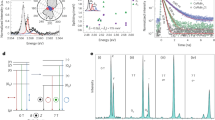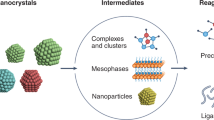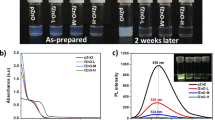Abstract
Applications of colloidal nanocrystals in polar solvents often require nanocrystals synthesized in non-polar solvents. However, solvent transfer processes are problematic and deteriorate nanocrystal quality. Here we report syntheses of nanocrystals with nearly universal solvent dispersibility using ligands and solvents with alkoxy repeating units. Core syntheses, shell deposition and cation exchange proceed similarly to traditional methods while products are more stable in aqueous solution than those generated by solvent transfer. (CdSe)CdZnS nanocrystals retain photoluminescence in cells for single-particle tracking experiments and outperform other nanocrystal classes in diffusion metrics reflecting stability and resistance to non-specific binding. Distinct reaction classes yield nanocrystals with either methoxy or hydroxy ligand terminations, both of which can be purified by aqueous methods that are chemically greener than traditional methods. These reactions can further generate nanocrystals with diverse oxide, sulfide and selenide compositions, shapes and spectral bands with wide dispersibility that may make applications in polar solvents more widely accessible.

This is a preview of subscription content, access via your institution
Access options
Subscribe to this journal
Receive 12 digital issues and online access to articles
$119.00 per year
only $9.92 per issue
Buy this article
- Purchase on SpringerLink
- Instant access to full article PDF
Prices may be subject to local taxes which are calculated during checkout






Similar content being viewed by others
Data availability
Relevant data are provided within the Supplementary Information. Source data are provided with this paper.
References
Murray, C. B., Norris, D. J. & Bawendi, M. G. Synthesis and characterization of nearly monodisperse CdE (E = S, Se, Te) semiconductor nanocrystallites. J. Am. Chem. Soc. 115, 8706–8715 (1993).
Yin, Y. & Alivisatos, A. P. Colloidal nanocrystal synthesis and the organic–inorganic interface. Nature 437, 664–670 (2005).
Nasilowski, M., Mahler, B., Lhuillier, E., Ithurria, S. & Dubertret, B. Two-dimensional colloidal nanocrystals. Chem. Rev. 116, 10934–10982 (2016).
Kwon, S. G. & Hyeon, T. Colloidal chemical synthesis and formation kinetics of uniformly sized nanocrystals of metals, oxides, and chalcogenides. Acc. Chem. Res. 41, 1696–1709 (2008).
Mocatta, D. et al. Heavily doped semiconductor nanocrystal quantum dots. Science 332, 77–81 (2011).
Drake, G. A., Keating, L. P. & Shim, M. Design principles of colloidal nanorod heterostructures. Chem. Rev. 123, 3761–3789 (2022).
McCormick, C. R., Katzbaer, R. R., Steimle, B. C. & Schaak, R. E. Combinatorial cation exchange for the discovery and rational synthesis of heterostructured nanorods. Nat. Synth. 2, 152–161 (2023).
Kagan, C. R., Lifshitz, E., Sargent, E. H. & Talapin, D. V. Building devices from colloidal quantum dots. Science 353, aac5523 (2016).
Liu, M. et al. Colloidal quantum dot electronics. Nat. Electron. 4, 548–558 (2021).
Park, Y.-S., Roh, J., Diroll, B. T., Schaller, R. D. & Klimov, V. I. Colloidal quantum dot lasers. Nat. Rev. Mater. 6, 382–401 (2021).
Chan, W. C. W. & Nie, S. M. Quantum dot bioconjugates for ultrasensitive nonisotopic detection. Science 281, 2016–2018 (1998).
Bruchez, M., Moronne, M., Gin, P., Weiss, S. & Alivisatos, A. P. Semiconductor nanocrystals as fluorescent biological labels. Science 281, 2013–2016 (1998).
Dubertret, B. et al. In vivo imaging of quantum dots encapsulated in phospholipid micelles. Science 298, 1759–1762 (2002).
Wu, X. Y. et al. Immunofluorescent labeling of cancer marker Her2 and other cellular targets with semiconductor quantum dots. Nat. Biotechnol. 21, 41–46 (2003).
Stavis, S. M., Fagan, J. A., Stopa, M. & Liddle, J. A. Nanoparticle manufacturing—heterogeneity through processes to products. ACS Appl. Nano Mater. 1, 4358–4385 (2018).
Shen, Y., Gee, M. Y. & Greytak, A. B. Purification technologies for colloidal nanocrystals. Chem. Commun. 53, 827–841 (2017).
Lim, H. et al. Continuous purification of colloidal quantum dots in large-scale using porous electrodes in flow channel. Sci. Rep. 7, 43581 (2017).
Jokerst, J. V., Lobovkina, T., Zare, R. N. & Gambhir, S. S. Nanoparticle PEGylation for imaging and therapy. Nanomedicine 6, 715–728 (2011).
De Roo, J. et al. Probing solvent–ligand interactions in colloidal nanocrystals by the NMR line broadening. Chem. Mater. 30, 5485–5492 (2018).
Larsen, T. H., Sigman, M., Ghezelbash, A., Doty, R. C. & Korgel, B. A. Solventless synthesis of copper sulfide nanorods by thermolysis of a single source thiolate-derived precursor. J. Am. Chem. Soc. 125, 5638–5639 (2003).
Jun, S., Jang, E. J. & Chung, Y. S. Alkyl thiols as a sulfur precursor for the preparation of monodisperse metal sulfide nanostructures. Nanotechnology 17, 4806–4810 (2006).
Ma, L. et al. Multidentate polymer coatings for compact and homogeneous quantum dots with efficient bioconjugation. J. Am. Chem. Soc. 138, 3382–3394 (2016).
Ithurria, S. & Talapin, D. V. Colloidal atomic layer deposition (c-ALD) using self-limiting reactions at nanocrystal surface coupled to phase transfer between polar and nonpolar media. J. Am. Chem. Soc. 134, 18585–18590 (2012).
Aldana, J., Wang, Y. A. & Peng, X. G. Photochemical instability of CdSe nanocrystals coated by hydrophilic thiols. J. Am. Chem. Soc. 123, 8844–8850 (2001).
Pellegrino, T. et al. Hydrophobic nanocrystals coated with an amphiphilic polymer shell: a general route to water soluble nanocrystals. Nano Lett. 4, 703–707 (2004).
Smith, A. M. & Nie, S. M. Minimizing the hydrodynamic size of quantum dots with multifunctional multidentate polymer ligands. J. Am. Chem. Soc. 130, 11278–11279 (2008).
Turo, M. J. & Macdonald, J. E. Crystal-bound vs surface-bound thiols on nanocrystals. ACS Nano 8, 10205–10213 (2014).
Zahid, M. U., Ma, L., Lim, S. J. & Smith, A. M. Single quantum dot tracking reveals the impact of nanoparticle surface on intracellular state. Nat. Comm. 9, 1830 (2018).
Cai, E. et al. Stable small quantum dots for synaptic receptor tracking on live neurons. Angew. Chem. Int. Ed. 53, 12484–12488 (2014).
Etoc, F. et al. Non-specific interactions govern cytosolic diffusion of nanosized objects in mammalian cells. Nat. Mater. 17, 740–746 (2018).
Katrukha, E. A. et al. Probing cytoskeletal modulation of passive and active intracellular dynamics using nanobody-functionalized quantum dots. Nat. Comm. 8, 14772 (2017).
Zhu, Z. J. et al. Stability of quantum dots in live cells. Nat. Chem. 3, 963–968 (2011).
Cai, R. et al. Dynamic intracellular exchange of nanomaterials’ protein corona perturbs proteostasis and remodels cell metabolism. Proc. Natl Acad. Sci. USA 119, e2200363119 (2022).
Pietryga, J. M. et al. Utilizing the lability of lead selenide to produce heterostructured nanocrystals with bright, stable infrared emission. J. Am. Chem. Soc. 130, 4879–4885 (2008).
Lim, S. J. et al. Lipoprotein nanoplatelets: brightly fluorescecent, zwitterionic probes with rapid cellular entry. J. Am. Chem. Soc. 138, 64–67 (2016).
Nasilowski, M., Nienhaus, L., Bertram, S. N. & Bawendi, M. G. Colloidal atomic layer deposition growth of PbS/CdS core/shell quantum dots. Chem. Commun. 53, 869–872 (2017).
Smith, A. M., Mancini, M. C. & Nie, S. M. Second window for in vivo imaging. Nat. Nanotech. 4, 710–711 (2009).
Wohlfarth, C. in Static Dielectric Constants of Pure Liquids and Binary Liquid Mixtures (ed. Lechner, M. D.) 138 (Springer-Verlag, 2015).
Wohlfarth, C. in Static Dielectric Constants of Pure Liquids and Binary Liquid Mixtures (ed. Lechner, M. D.) 184 (Springer-Verlag, 2015).
Monego, D. et al. When like destabilizes like: inverted solvent effects in apolar nanoparticle dispersions. ACS Nano 14, 5278–5287 (2020).
Ito, D., Yokoyama, S., Zaikova, T., Masuko, K. & Hutchison, J. E. Synthesis of ligand-stabilized metal oxide nanocrystals and epitaxial core/shell nanocrystals via a lower-temperature esterification process. ACS Nano 8, 64–75 (2014).
Chen, J., Spear, S. K., Huddleston, J. G. & Rogers, R. D. Polyethylene glycol and solutions of polyethylene glycol as green reaction media. Green Chem. 7, 64–82 (2005).
Ahmed, S. F. et al. Green approaches in synthesising nanomaterials for environmental nanobioremediation: technological advancements, applications, benefits and challenges. Environ. Res. 204, 111967 (2022).
Varma, R. S. Greener and sustainable trends in synthesis of organics and nanomaterials. ACS Sustain. Chem. Eng. 4, 5866–5878 (2016).
Chen, O. et al. Synthesis of metal-selenide nanocrystals using selenium dioxide as the selenium precursor. Angew. Chem. Int. Ed. 47, 8638–8641 (2008).
Lim, S. J. et al. Brightness-equalized quantum dots. Nat. Comm. 6, 8210 (2015).
Jaqaman, K. et al. Robust single-particle tracking in live-cell time-lapse sequences. Nat. Methods 5, 695–702 (2008).
Acknowledgements
This work was supported by funds from the National Institutes of Health (grant nos. R01CA227699, R01GM131272, R01EB032249 and R01EB032725 to A.M.S.) and the National Science Foundation (grant nos. 2232681 to A.M.S. and 1746047 to E.I.H.A.). This work used the Delta system at the National Center for Supercomputing Applications through allocation MAT230021 from the Advanced Cyberinfrastructure Coordination Ecosystem: Services & Support (ACCESS) program, supported by National Science Foundation grants (nos. 2138259, 2138286, 2138307, 2137603 and 2138296). We are grateful to L. Zhu for valuable help with NMR experiments.
Author information
Authors and Affiliations
Contributions
S.S. and A.M.S. conceived and designed the experiments, characterizations and contributed to the chemical theory. S.S. performed all chemical syntheses and optical characterizations. O.H.A. performed all studies related to living cells including single-particle tracking and cytotoxicity experiments and related data analyses. Y.C. synthesized urea-based reagents and performed NMR characterizations and related data analyses. E.I.H.A. performed CdS nanocrystal syntheses as well as XPS characterization and related data analyses. E.I.H.A. and A.S. designed and performed DFT simulations. S.S. and A.M.S. wrote the paper. All authors edited the manuscript.
Corresponding author
Ethics declarations
Competing interests
The authors declare no competing interests.
Peer review
Peer review information
Nature Synthesis thanks Emil A. Hernandez-Pagan and the other, anonymous, reviewer(s) for their contribution to the peer review of this work. Primary Handling Editor: Alexandra Groves, in collaboration with the Nature Synthesis team.
Additional information
Publisher’s note Springer Nature remains neutral with regard to jurisdictional claims in published maps and institutional affiliations.
Supplementary information
Supplementary Information
Tables 1–7, Figs. 1–20, Discussion, Methods and Refs.
Source data
Source Data Fig. 2
Statistical source data.
Source Data Fig. 4
Statistical source data.
Source Data Fig. 5
Statistical source data.
Source Data Fig. 6
Statistical source data.
Rights and permissions
Springer Nature or its licensor (e.g. a society or other partner) holds exclusive rights to this article under a publishing agreement with the author(s) or other rightsholder(s); author self-archiving of the accepted manuscript version of this article is solely governed by the terms of such publishing agreement and applicable law.
About this article
Cite this article
Sarkar, S., Arogundade, O.H., Cui, Y. et al. Nanocrystal synthesis with alkoxy reagents for dispersion in polar and non-polar solvents. Nat. Synth 4, 826–835 (2025). https://doi.org/10.1038/s44160-025-00764-0
Received:
Accepted:
Published:
Issue date:
DOI: https://doi.org/10.1038/s44160-025-00764-0



